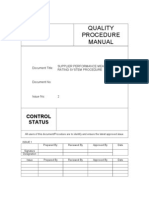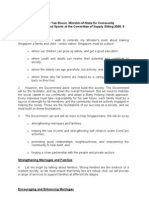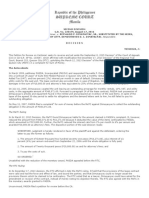TL 9000 Quality Management System Measurements Handbook FRT Examples
TL 9000 Quality Management System Measurements Handbook FRT Examples
Uploaded by
محمود علي الخطيبCopyright:
Available Formats
TL 9000 Quality Management System Measurements Handbook FRT Examples
TL 9000 Quality Management System Measurements Handbook FRT Examples
Uploaded by
محمود علي الخطيبOriginal Title
Copyright
Available Formats
Share this document
Did you find this document useful?
Is this content inappropriate?
Copyright:
Available Formats
TL 9000 Quality Management System Measurements Handbook FRT Examples
TL 9000 Quality Management System Measurements Handbook FRT Examples
Uploaded by
محمود علي الخطيبCopyright:
Available Formats
Quality Excellence for Suppliers of Telecommunications Forum (QuEST Forum)
TL 9000 Quality Management System Measurements Handbook FRT Examples
Copyright 2011 QuEST Forum
Fix Response Time (FRT) Examples
5.2
FRT Examples
Problem reports from customers are expected to produce an action by the supplier to fix or alleviate the problem (see definition of Problem Report in the Glossary). The problem fix is to be delivered in a time frame determined the rules in 5.2.4 d) 1). Since FRT deals only with reported problems from customers and the responsiveness of the supplier to fixing the problem, the FRT measurement is not normalized but reported as a percentage of problems fixed on time. It may be that an organization has no problems to fix in a particular month. In that case 0 is reported for the number of problems fixed and also for the number of problems due to be fixed, which results in an FRT of 100%.
5.2.1 FRT for Product Categories 1, 2, 3, 4, 5, 6, and 9
Since problem reports in product categories 1, 2, 3, 4, 5, 6, and 9 are classified by severity, FRT is also reported by severity. Critical problem reports are those problem reports that must be addressed immediately and continuously until resolved. Since the fix for critical problem reports cannot be scheduled there is no measure of FRT for critical problem reports. FRT in these product categories applies only to major and minor problem reports. 1) Consider one months data for one product category for one TL 9000 registration. There are five major problem reports due to be closed during the month and all five were closed on time. There are 25 minor problem reports due and 20 were closed on time. 2) The data reported is shown in Table 5.2.1-1.
Table 5.2.1-1 FRT Data Table Report for Product Categories 1, 2, 3, 4, 5, 6, and 9
Identifier MeasurementID Fr2c Fr2d Fr3c Fr3d Value FRT 5 5 20 25
3) The measurement calculation result is shown in Table 5.2.1-2.
Table 5.2.1-2 FRT Source Data and Measurement Calculation for Product Categories 1, 2, 3, 4, 5, 6, and 9
Fixes Available On Time Fr2c = 5 Fr3c = 20 Severity Fixes Due FRT Measurement Results Problem Reports Closed On Time FRT2 = 100% FRT3 = 80%
Major Minor
Fr2d = 5 Fr3d = 25
The calculation of FRT2 is 100 * 5 / 5 = 100%. The calculation of FRT3 is 100 * 20 / 25 = 80%.
Copyright 2011 QuEST Forum Version 1.1
FRT Examples 5.2-1
Fix Response Time (FRT) Examples
5.2.2 FRT for Product Category 7 and 8
Problem reports in product categories 7 and 8 are not classified by severity. All problem reports are considered equally weighted. 1) Consider one months data for an organization of a particular installation service. There are 20 problem reports due to be closed during the month and 16 were closed on time. 2) The data reported is shown in Table 5.2.2-1.
Table 5.2.2-1 FRT Data Table Report for Product Categories 7 and 8
Identifier Product Category MeasurementID Fr4c Fr4d Value 7.1 FRT 16 20
3) The calculation of the measurement is shown in Table 5.2.2-2.
Table 5.2.2-2 FRT Source Data and Measurement Calculation for Product Categories 7 and 8
Fixes Available On Time Fr4c = 16 Fixes Due Fr4d = 20 FRT Measurement Results Problem Reports Closed On Time FRT4 = 80%
The calculation of FRT4 is 100 * 16 / 20 = 80%.
5.2.3 Effect of Customer Delay
According to counting rule 5.2.4 b) 7) there are certain situations where delays can be excluded from the overall closure time and fix date can be adjusted. For example, if access to a site to fix a problem is denied for a certain period of time then the time the access is denied can be excluded. Suppose a major problem report is received on March 1 and that there is no service level agreement in place with the customer. In this case, according to 5.2.4 d) 1), the due date for fixing this major problem is March 31. On March 10, the supplier determines that they need access to the customers site to be able to fix the problem. On March 12, the customer tells them that they cant gain access to site until April 1. This is summarized in Table 5.2.3-1.
Table 5.2.3-1 Effect of Customer Delay
Event Major Problem Report Received Need for site access identified Customer informs site not available until April 1 Site Available Event Date March 1 March 10 March 12 April 1 Problem Closure Due Date March 31 March 31 Due date suspended April 18
Copyright 2011 QuEST Forum Version 1.1
FRT Examples 5.2-2
Fix Response Time (FRT) Examples
They may exclude the interval that access to the site was denied (March 12 through 31), which has the effect of moving the due date of the problem report from March 31 to April 18. If they fix the problem on or before April 18, then the problem was fixed on time. The problem report is therefore reported with the April data per counting rule 5.2.4 b) 4).
5.2.4 Effect of Fix Deferral
If the customer agrees, the delivery of a fix may be deferred such as waiting to deliver the fix in the next software release. In these cases, according to counting rule 5.2.4 b) 9), the interval between the time when the fix is identified and when it is delivered can be excluded for the overall fix response time. For example, suppose a major problem is reported on June 1 with a closure due date of July 1. The supplier fixes the problem on June 20 but the customer wants to defer delivery until the next major release of the software, which occurs on December 15. This situation is summarized in Table 5.2.4-1.
Table 5.2.4-1 Effect of Fix Deferral
Event Major Problem Report Received Fix deferred to Release R3.1 Release R3.1 Delivery Event Date June 1 June 20 Dec 15 Problem Closure Due Date July 1 Release R3.1 Delivery Dec 15
The problem is due to be fixed in December and reported with in the December FRT data submission. It is not considered due nor reported in the preceding months of July through November. If Release R3.1 contains the fix to the problem report and the fix works, then the problem report is counted on time. If Release R3.1 does not fix the problem, then the problem report must be reported as due but not fixed in July. This will require a resubmission of the July data. Furthermore, it is now overdue and according to counting rule 5.3.4 b) 3) must be reported as overdue in all months from July through December and continuing until it is fixed. This also will require resubmission of the August through November data.
5.2.5 Effect of Incomplete Fix
A fix was delivered within the time required by an SLA. But at a later point in time if the customer rejects the fix as incomplete because it was ineffective or unusable or had some undesirable side effects caused by installation of the fix, then in these cases, according to counting rule 5.2.4 b) 3) the problem report shall be re-classified as open. All intervening time shall be included in determining on-time problem closures as if the fix had not been delivered. For example, suppose a major problem is reported on June 1 with a closure due date of June 3. The supplier fixes the problem on June 2, but later the customer rejects the fix on August 15. This situation is summarized in Table 5.2.5-1.
Copyright 2011 QuEST Forum Version 1.1
FRT Examples 5.2-3
Fix Response Time (FRT) Examples
Table 5.2.5-1 Effect of Incomplete Fix
Event Major Problem Report Received Supplier provides the fix Customer rejects the fix Event Date June 1 June 2 Aug 15 Problem Closure Due Date June 3 June 3 June 3
The problem is due to be fixed in June and reported in the June FRT data submission. On August 15 Customer finds that the problem is not completely fixed and rejects the fix, then the problem report must be reported as due but not fixed in June. This will require a resubmission of the June data. Furthermore, it is now overdue and according to counting rule 5.3.4 b) 2) must be reported as overdue in all months from June through August and continuing until it is fixed. This also will require OFR data resubmission of the June through August data.
5.2.6 FRT Counting Aid
According to counting rule 5.3.4 b) 4), for FRT, problem reports are counted once, ONLY in the month they are due and not in the month they are fixed or closed. Following table serves as a quick check for deciding whether to count a problem report for calculating FRT or not depending on various possible scenarios on timeliness of the fix in a given month (say July).
Table 5.2.6-1 FRT Counting Summary Table
Problem Report Scenario To be Counted in current month (July)? Due in the month and Closed before Closed in June, Due only Yes the month (early fix) in July Closed in the month and Due in Closed in July, Due only No future month (early fix) in August Due and Closed in the month on time Closed on July 20, Due Yes on July 20 (timely fix) Closed in the month and Due in Closed in July, Due in No previous month (late fix) June Due and Closed in the month but Closed on July 20, Due Yes after time (late fix) on July 18 Due in the month and still open Due on July 20 and still Yes Open Example
Copyright 2011 QuEST Forum Version 1.1
FRT Examples 5.2-4
You might also like
- State and Local Tax Outline, Fall 2011Document98 pagesState and Local Tax Outline, Fall 2011wrzmstr2100% (1)
- Nigeria Solid Mineral Development Company NSMDC Bill 24.10.23Document20 pagesNigeria Solid Mineral Development Company NSMDC Bill 24.10.23Adakole ObekaNo ratings yet
- SITXFIN003 Assessment 2 - ProjectDocument6 pagesSITXFIN003 Assessment 2 - ProjectJot Khehra0% (3)
- A History of The British Presence in ChileDocument273 pagesA History of The British Presence in ChileRoger MillsNo ratings yet
- Month End Closing Procedures 0Document9 pagesMonth End Closing Procedures 0narasi64No ratings yet
- 8.5.2-3 Corrective and Preventive ActionDocument4 pages8.5.2-3 Corrective and Preventive ActionAhmed HussienNo ratings yet
- TCAP Engineer's Reponse On MPR June-24 C3 PackageDocument4 pagesTCAP Engineer's Reponse On MPR June-24 C3 PackageSayan GhoshNo ratings yet
- The GUIDE IN ACCOMPLISHING MRC VER. 2.0Document28 pagesThe GUIDE IN ACCOMPLISHING MRC VER. 2.0malvarbatangas.mctcNo ratings yet
- MJ24 AA Examiner's ReportDocument22 pagesMJ24 AA Examiner's ReportKashif KamranNo ratings yet
- Usd Deferral Process and Policies: Type Value of Bug. No Specific Process Is Specified For Ars With Other Type ValuesDocument6 pagesUsd Deferral Process and Policies: Type Value of Bug. No Specific Process Is Specified For Ars With Other Type Valuesabhayarya2000No ratings yet
- Individual Goals CommentDocument4 pagesIndividual Goals CommentSubroto DasNo ratings yet
- FR M2 - Module Quiz 1 (Part A) - KnowledgEquityDocument13 pagesFR M2 - Module Quiz 1 (Part A) - KnowledgEquityThế Dân NguyễnNo ratings yet
- Annex Vi A Interreport enDocument3 pagesAnnex Vi A Interreport enBrian Ferndale GarciaNo ratings yet
- FAQs About GSTR 3B and GSTR 1 Mistakes and How To Fix ThemDocument4 pagesFAQs About GSTR 3B and GSTR 1 Mistakes and How To Fix ThemIris GSTNo ratings yet
- Grant Contract Annex VI Interim Narrative ReportDocument4 pagesGrant Contract Annex VI Interim Narrative ReportMurat OcakNo ratings yet
- Performance Improvement Plan Template 03Document2 pagesPerformance Improvement Plan Template 03wida acNo ratings yet
- Schedule Check ListDocument3 pagesSchedule Check ListkontractsmanagerNo ratings yet
- Ultratech Cement LTD, Unit: Birla White:, Total Quality Integrated Management System Procedure ForDocument3 pagesUltratech Cement LTD, Unit: Birla White:, Total Quality Integrated Management System Procedure ForJogender KumarNo ratings yet
- Ey Apply Ifrs Accounting For Climate Change August 2023 - v2Document68 pagesEy Apply Ifrs Accounting For Climate Change August 2023 - v2Abder AouadNo ratings yet
- TX ZAF Examiner's ReportDocument9 pagesTX ZAF Examiner's ReportKevin KausiyoNo ratings yet
- 3-10 Vol-3 Empl Reqt - Appendix-1 To 9Document88 pages3-10 Vol-3 Empl Reqt - Appendix-1 To 9raviteja_235998131No ratings yet
- 3bgoods and Services TaxDocument39 pages3bgoods and Services Taxmonishabala17No ratings yet
- Schedule 5.1 Milestone Payments and Claims ProcedureDocument20 pagesSchedule 5.1 Milestone Payments and Claims ProcedureKris NauthNo ratings yet
- Release NotesDocument4 pagesRelease Notesxisowal978No ratings yet
- Block 3 Lecture 10Document8 pagesBlock 3 Lecture 10adeelpfizerNo ratings yet
- DOC52PAPT0801006 Attachment 1: Contract Deliverable DescriptionDocument13 pagesDOC52PAPT0801006 Attachment 1: Contract Deliverable DescriptionKusal HettiarachchiNo ratings yet
- Call Monitoring Feedback ProcedureDocument4 pagesCall Monitoring Feedback Procedureakeyz08No ratings yet
- ReleaseNotesDocument4 pagesReleaseNotesshiurya432No ratings yet
- Project Completion PPM Version 2.0Document14 pagesProject Completion PPM Version 2.0Adi JuniawanNo ratings yet
- CMS-855B - Editable Short VersionDocument4 pagesCMS-855B - Editable Short VersionLukaNo ratings yet
- 5.06 Milestone Review - Phase 4Document9 pages5.06 Milestone Review - Phase 4nsadnanNo ratings yet
- Accounting For Climate ChangeDocument59 pagesAccounting For Climate ChangeJoaoNo ratings yet
- Quarterly Physical Report of OperationDocument3 pagesQuarterly Physical Report of OperationJaeriel BersaminaNo ratings yet
- HCES Online Report Generator (Updated 06-07-2023)Document76 pagesHCES Online Report Generator (Updated 06-07-2023)bpdh.nursingserviceNo ratings yet
- Project Completion PPM Version 2.0Document13 pagesProject Completion PPM Version 2.0keys.linkNo ratings yet
- Project Completion PPM Version 2.1Document14 pagesProject Completion PPM Version 2.1mangulaNo ratings yet
- WINDOWDocument4 pagesWINDOWSalahudheen anas TNo ratings yet
- Goods and Services Tax - Payment of Taxes & Filing of Form GSTR-3B ReturnDocument45 pagesGoods and Services Tax - Payment of Taxes & Filing of Form GSTR-3B ReturnANAND AND COMPANYNo ratings yet
- Contemporary Issues in AccountingDocument45 pagesContemporary Issues in AccountingRamneet Parmar100% (2)
- ANDA Filing and Refuse To Receive Issues: Johnny Young, M.A.L.ADocument39 pagesANDA Filing and Refuse To Receive Issues: Johnny Young, M.A.L.AJoe Luis Villa MedinaNo ratings yet
- Bai Bao - ENDocument6 pagesBai Bao - ENphuonganh1001No ratings yet
- Criteria Status As of Fy 2018 (7) Target in Fy 2019 (8) Fy 2019 Status of Streamlining Efforts (9) RemarksDocument3 pagesCriteria Status As of Fy 2018 (7) Target in Fy 2019 (8) Fy 2019 Status of Streamlining Efforts (9) RemarksCliffordNo ratings yet
- Events After Reporting Period Tutorial Solution - 2024Document5 pagesEvents After Reporting Period Tutorial Solution - 2024NDza La Ma ARNo ratings yet
- Return Compliance in Form DRC 01bDocument25 pagesReturn Compliance in Form DRC 01btbrindha57No ratings yet
- Supplier Performance Measure Rating SystemDocument12 pagesSupplier Performance Measure Rating SystemPaulo Lindgren0% (1)
- Ey Apply Ifrs Accounting For Climate Change Updated May 2022Document53 pagesEy Apply Ifrs Accounting For Climate Change Updated May 2022Mayra FloresNo ratings yet
- VM Supplier Schedule A User GuideDocument9 pagesVM Supplier Schedule A User Guidec_e_z_a_rNo ratings yet
- MAC3703 Compulsory Assignment 2 All Other 2021Document13 pagesMAC3703 Compulsory Assignment 2 All Other 2021SibongileNo ratings yet
- Annual Report1920 Smarts HelpguideDocument17 pagesAnnual Report1920 Smarts Helpguidejones3.joshuaNo ratings yet
- 008.1 - EXHIBIT G - Attachment G1Document7 pages008.1 - EXHIBIT G - Attachment G1lxz861020No ratings yet
- R P K P Awanihan NG Entas NternasDocument7 pagesR P K P Awanihan NG Entas NternasYna YnaNo ratings yet
- Form1 SaDocument4 pagesForm1 SaxoNo ratings yet
- IFRS Model Financial Statements 2020 - Appendix 2Document12 pagesIFRS Model Financial Statements 2020 - Appendix 2Pawan GautamNo ratings yet
- Large Electrical Parts RetailerDocument5 pagesLarge Electrical Parts RetailerCharlotteNo ratings yet
- GBS Project Service Center: Financial Process Monthly Reporting (IPPF)Document16 pagesGBS Project Service Center: Financial Process Monthly Reporting (IPPF)smgalloNo ratings yet
- CCR Activity Reporting FormDocument3 pagesCCR Activity Reporting Formuser55No ratings yet
- 201 2011 2 eDocument18 pages201 2011 2 eVicky TruterNo ratings yet
- Improved Delivery of Reemployment AssistanceDocument204 pagesImproved Delivery of Reemployment AssistanceDale Greenstein100% (1)
- LGU DTP Rapid Quality Assessment Form 2 Date Accomplished: - City / Municipality: Province: RegionDocument5 pagesLGU DTP Rapid Quality Assessment Form 2 Date Accomplished: - City / Municipality: Province: RegionCDS Cavite DILGNo ratings yet
- Functional Specification - Accounts - Version 1 0 - June 25-6-2008Document53 pagesFunctional Specification - Accounts - Version 1 0 - June 25-6-2008Aditham Subba RaoNo ratings yet
- ROBG EMS Guidance Reporting v2Document41 pagesROBG EMS Guidance Reporting v2Catalin MihailescuNo ratings yet
- Career Change From Real Estate to Oil and Gas ProjectsFrom EverandCareer Change From Real Estate to Oil and Gas ProjectsRating: 5 out of 5 stars5/5 (1)
- RegLandscape AlcatelUSDocument2 pagesRegLandscape AlcatelUSمحمود علي الخطيبNo ratings yet
- ProdCat Tables 4-5Document73 pagesProdCat Tables 4-5محمود علي الخطيبNo ratings yet
- ProdCat Tables 3-8Document65 pagesProdCat Tables 3-8محمود علي الخطيبNo ratings yet
- ProdCat Tables 3-5Document56 pagesProdCat Tables 3-5محمود علي الخطيبNo ratings yet
- ProdCat Tables 2-5Document29 pagesProdCat Tables 2-5محمود علي الخطيبNo ratings yet
- Phase Transition MonitoringDocument2 pagesPhase Transition Monitoringمحمود علي الخطيبNo ratings yet
- PDR Report Otd 1Document4 pagesPDR Report Otd 1محمود علي الخطيبNo ratings yet
- Mobile Services: Tax InvoiceDocument4 pagesMobile Services: Tax InvoiceAnonymous zwCV8ZNo ratings yet
- MSDS KAIGO Radiator Coolant Super 50Document4 pagesMSDS KAIGO Radiator Coolant Super 50Gendon ArkanaNo ratings yet
- Ann 2Document2 pagesAnn 2Kedriner LabanNo ratings yet
- HUM130 Week7 HeckpointDocument3 pagesHUM130 Week7 HeckpointTiphani Rene'No ratings yet
- Committee of Supply Sitting 2008 - Part 2, Speech by Mrs Yu-Foo Yee Shoon, 5 Mar 2008Document10 pagesCommittee of Supply Sitting 2008 - Part 2, Speech by Mrs Yu-Foo Yee Shoon, 5 Mar 2008dbmcysNo ratings yet
- Harshita DidelDocument7 pagesHarshita DidelAbhinav ShuklaNo ratings yet
- Joining BookletDocument7 pagesJoining Bookletsanjay sharmaNo ratings yet
- Contractors Registration Board: Application Form For First Registration As Contractors By-Law 3 (1) (A)Document17 pagesContractors Registration Board: Application Form For First Registration As Contractors By-Law 3 (1) (A)Hubert MubofuNo ratings yet
- PASDA Vs Dimayacyac (G.R. No. 220479 August 17, 2016)Document7 pagesPASDA Vs Dimayacyac (G.R. No. 220479 August 17, 2016)Ann ChanNo ratings yet
- Business Arithmetic Practise Problems ROI & ROEDocument19 pagesBusiness Arithmetic Practise Problems ROI & ROEvibhay vibhayNo ratings yet
- Investment in Equity and Debt SecuritiesDocument3 pagesInvestment in Equity and Debt SecuritiesBryan ReyesNo ratings yet
- GPS AgreementDocument7 pagesGPS Agreementzola1976No ratings yet
- Kohlberg's Moral DilemmaDocument24 pagesKohlberg's Moral DilemmaAIMI NABILAH BINTI MANDANGAN BP20110241No ratings yet
- Sop EnglishDocument42 pagesSop Englishapi-236690310No ratings yet
- Global Affairs Draft ModuleDocument150 pagesGlobal Affairs Draft Moduletadie degieNo ratings yet
- Historical Perspective of Ip Struggle in The PhilippinesDocument38 pagesHistorical Perspective of Ip Struggle in The Philippinesphoebe apayyoNo ratings yet
- My Lecture On Intellectual Property Rights in IndiaDocument24 pagesMy Lecture On Intellectual Property Rights in IndiaSuresh NaiduNo ratings yet
- List of Candidates For Recruitment Against Posts of Engineering BS 11 Local Council BoardDocument16 pagesList of Candidates For Recruitment Against Posts of Engineering BS 11 Local Council BoardAbdul Basit KhattakNo ratings yet
- Mergers and Acquisitions: Rights Reserved. Mcgraw-Hill/IrwinDocument23 pagesMergers and Acquisitions: Rights Reserved. Mcgraw-Hill/Irwinkkn35No ratings yet
- .Normal Period of Policing System, Westminister Period of Policing System, Spanish RegimeDocument5 pages.Normal Period of Policing System, Westminister Period of Policing System, Spanish RegimeCherrilyn TerezNo ratings yet
- Grammar AdjunctsDocument4 pagesGrammar AdjunctsTanja IvanovskaNo ratings yet
- Light Concentration Increase RaysDocument9 pagesLight Concentration Increase RaysAnonymous 7R6n0f9BY100% (2)
- GoToGate FBDocument1 pageGoToGate FBAvinash RajbharNo ratings yet
- Award Brief: CTBUH 2023 International ConferenceDocument4 pagesAward Brief: CTBUH 2023 International ConferenceMuhammad Alim MajidNo ratings yet
- Abas Lukma Final ThesisDocument95 pagesAbas Lukma Final ThesisAbas Lukman ShewajoNo ratings yet
- University of Eastern Philippines Laoang CampusDocument4 pagesUniversity of Eastern Philippines Laoang CampusEngr CKDNo ratings yet
- ( ( ( (Funding Agreement Contract) ) )Document7 pages( ( ( (Funding Agreement Contract) ) )Jase KuNo ratings yet
































































































